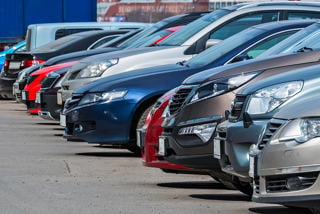A dramatic decline in the supply of new cars to the daily rental sector, coupled with a growing demand for vehicles, has left fleets facing last-minute cancellations and difficulty accessing short-term hires.
Overall, new car volumes fell by just 2% in Q1, compared with the first three months of last year.
However, the rental market experienced a 72% slump over the same time period, just 7,393 cars registered, down almost 19,000 units.
Some carmakers, including Mazda, Nissan, Seat and Volkswagen, registered no cars to rental companies in Q1.
The sales data suggests that manufacturers are diverting what new car stock is available into other, more profitable sectors, leaving rental companies having to work vehicles harder and for longer.
REASONS FOR SHORTFALL
A global shortage of semiconductors, exacerbated by the war in Ukraine, is being blamed for the squeeze in new car supply.
Fleets are facing long lead times, illustrated by a 32% year-on-year fall in company car registrations in April.
The Society of Motor Manufacturers and Traders (SMMT) has also revised its market outlook down for 2022, with 1.72 million new cars now expected to be registered during the year, down from the 1.89 million outlook in January.
“The current vehicle supply issue is complex,” said Ron Santiago, managing director of Europcar Mobility Group UK.
“The well-documented delays in new vehicle production have hit every part of the supply chain including the fleet sector, which is so fundamental to UK mobility.
“Europcar Mobility Group UK has worked hard with our manufacturer partners to maintain a good level of fleet.
“However, the reality is that the needs of the fleet and corporate sector have changed radically in the past 12 months – largely as a consequence of the delays in new vehicle delivery – and we have had to adjust our services in response.”
Santiago told Fleet News that there is a “vicious circle” in terms of vehicle supply and demand. “Leasing companies need vehicles returned at the end of lease periods, but that leaves drivers waiting for new vehicles without mobility,” he explained.
“Rental is therefore being used as a gap filler for these customers, but as the vehicle delays continue this often means businesses extend the rental period way beyond usual patterns. And that means there may not be a vehicle for the ‘next’ customer.”
In a double-whammy, daily rental firms, faced with a decline in demand during the pandemic, have reduced the vehicle numbers on their fleets.
Adrian Bewley, assistant vice-president of business rental at Enterprise, said: “We started adding vehicles back into our fleet as demand began to return early last summer, making commitments for new vehicle purchases from our manufacturing partners so we could refresh our fleet as we normally would and also meet returning demand.
“While global vehicle supply is tighter, we’re working closely with our OEM partners to add new vehicles as available.”
Enterprise buys the vast majority of its fleet ‘at risk’, which has enabled it to extend the fleet cycle and retain its vehicles for slightly longer.
“We’re working hard to accommodate all customers while firmly prioritising our contracted business customers that have committed to working with us,” continued Bewley.
“We want to ensure those who need a replacement vehicle while theirs is being repaired have one, and those who are travelling for work have the mobility they need.”
IMPACT ON FLEETS
Dale Eynon, director of Defra Group Fleet Services, told the Fleet News at 10: “The whole thing is a real mess at the moment and planning is incredibly difficult.
“What we are finding is last-minute cancellations, where people are holding on to rentals and there’s very little we can do about that.”
In response, he has increased the number of pool cars on fleet by utilising some lease cars returned by drivers and is persuading people to use other travel options.
“It’s not gone down well; people are used to picking up the phone and a rental car appearing the next day,” he said.
On one occasion, Eynon says a van was delivered to an employee who was expecting a car.
“We’re also finding that cars are travelling longer distances to be delivered, which is obviously not good for carbon (emissions),” he added.
Matt Hammond, head of fleet at Altrad, explained he was “stretching vehicles” wherever he could.
“We’re trying to change the structure of how we operate, looking at how we can move people and jobs around to align so we’re not having those peaks and troughs in vehicle demand,” he said.
Given the pressures on vehicle supply, he added: “The rental companies are trying their best.”
Lorna McAtear, fleet manager at the National Grid, was similarly sympathetic. “If you think that any issue a fleet manager has in purchasing a vehicle, hire companies have that worse, because they are at the bottom of the pile,” she said.
As well as issues around the type of vehicle being supplied, McAtear said she was finding condition was an issue. She explained: “Drivers are expecting a nice, clean hire vehicle with a low mileage and they’re getting vehicles that have been held on to longer by the rental company.”
Due to the high utilisation rates of vehicles on rental company fleets, they were unable to prepare them properly for the next hire, she said.
“We’re also finding that if we do a one-day hire we won’t get it. We’re needing to do hires for longer periods, because the rental companies can’t afford to give you those vehicles for spot day hires any more.”
MacAtear says it has meant telling employees to look at alternatives.
Duncan Webb, head of fleet for the UK and Ireland at ISS, estimates that the rental market is probably around 50,000 vehicles short of where it needs to be.
Average bookings through a broker network, for example, are taking eightto-10 times more approaches to find somebody to fulfil the order, he said.
With problems expected to persist well into next year, Webb also fears how heightened demand at the end of this year will impact the market.
“Christmas carnage is on its way,” he told Fleet News at 10. “If we think it’s bad now, it’s going to get worse.
“If you are lucky enough to be receiving vehicles from your supply chain at the moment, seriously plan around whether you can keep them, perhaps through a 12-month extension to your lease.”
Cox Automotive is predicting that the supply of new cars and vans could get worse, and prices could rise further, while the Russia/ Ukraine conflict continues.
Both countries play a substantial part in the European and global automotive markets, providing raw materials, including gases and microchip production, palladium and platinum, wire harnesses, aluminium and cobalt.
Half of the world’s output of neon and 40% of the world’s krypton, which are needed to manufacture semiconductor chips, comes from the Ukraine.
Ukraine also produces wiring harnesses, which are used in car production, while Russia is the primary supplier of palladium, which is in catalytic converters to help vehicles meet emissions requirements, and plays a large part in aluminium supply.
Aluminium shortages are expected in the coming months, which will drive up raw material prices.
Electric car production could also be affected by shortages in cobalt production, which is used as a component of lithium-ion batteries. Russia was the second-largest producer of cobalt last year.
DELIVERIES CAN ‘FLUCTUATE’
Northgate Vehicle Hire told Fleet News it is still receiving new light commercial vehicles (LCVs) from manufacturers, including a recent delivery of more than 100 new Mercedes-Benz eVitos.
However, volumes and timings of deliveries can fluctuate from the company’s plans, according to Neil McCrossan, Northgate sales and marketing director. Northgate, which buys all of its vehicles, has been collaborating with customers to order new LCVs much earlier than normal to in consideration of the longer lead times.
“Our OEM partners are faced with many production challenges and through constant communication with our fleet team we are working through these together,” said McCrossan.
To maintain fleet size and liquidity, he says it is “inevitable”, given current circumstances, fleet replacement cycles are extending, but the company was still growing its fleet.
At Europcar, the proportion of its vehicles allocated to the fleet and corporate sector has also increased year-on-year.
CONSTANT DIALOGUE
Santiago explained: “We are in constant dialogue with our customers to ensure we can understand their needs and match our fleet wherever possible. We have also adjusted some of our fleet policies to respond to this exceptional situation.
“We have extended the average lifecycle for our vehicles, which, in turn, means more cars and vans are requiring servicing and maintenance as well as MOTs – unheard of in previous years.”
However, he said that the roll-out of its connected vehicle strategy, enabling it to know whether vehicles are ready for collection, and are situated at the intended pick-up point, is helping it take a more proactive approach to vehicle servicing, reducing the risk of unscheduled vehicle downtime.
He added: “We had anticipated this would be important in helping us understand where our vehicles were for improved operational efficiency.
“Little did we know quite how crucial it would be in managing customer demand in the context of the vehicle supply challenges.”
Read more on the impact of disruption to the rental market from James Pestell, AFP director.
























Login to comment
Comments
No comments have been made yet.